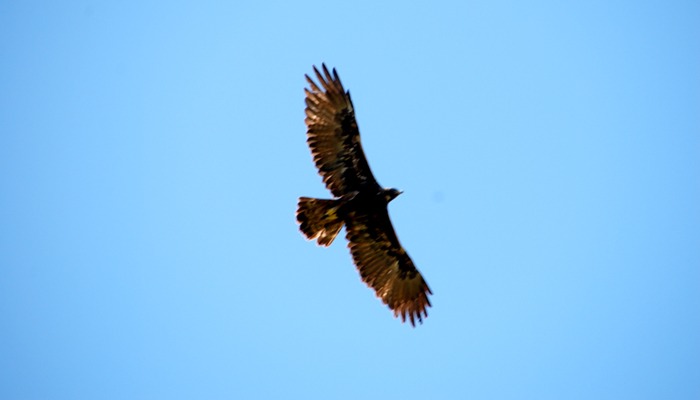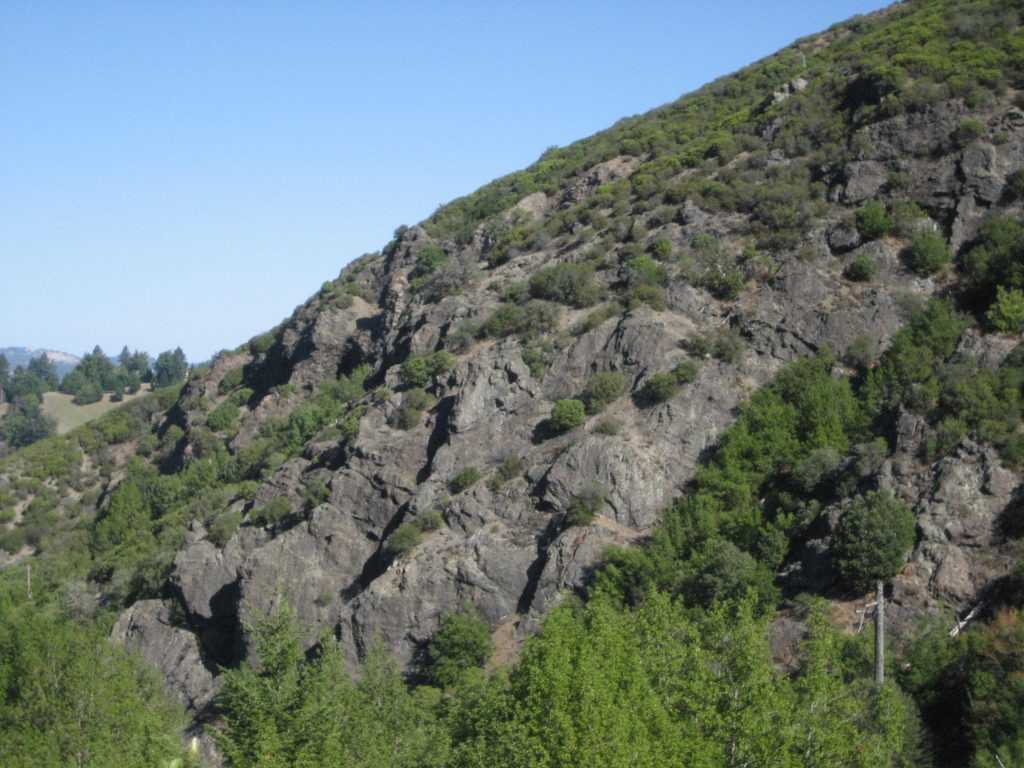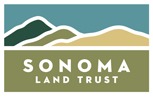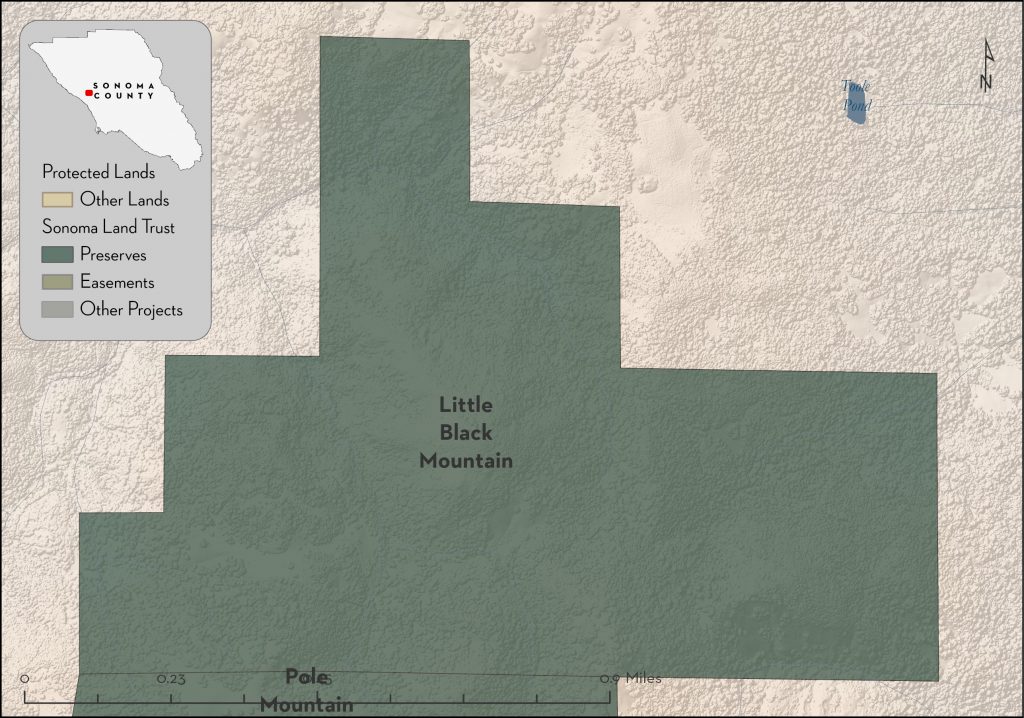LITTLE BLACK MOUNTAIN
The Gift of Conservation — the Gift of a Nature Preserve
When the Creighton Ridge Fire of 1978 swept through the Cazadero area, it left little in its path. Quickly burning through more than 12,000 acres, it scorched the 500-acre Little Black Mountain property in mere minutes, leveling the homestead of its owners, the Thieriot Family. Only the stone chimney was left as a reminder.
Devastated by the fire and loss of their home, the Thieriots left the state and gradually began deeding portions of their land to Sonoma Land Trust. As one of the Land Trust’s first properties, the Thieriot Family left their mark by dedicating their land as a nature preserve for the community’s education and enjoyment. The family stipulated in their donation that we should expand the preserve whenever we could. Decades later, we acquired the iconic Jenner Headlands and Pole Mountain properties (the latter adjacent to Little Black Mountain), thereby creating a 6,300-acre connected landscape. We thank the Thieriots for the gift of their land and their vision.
With an elevation ranging to 1,960 feet, Little Black Mountain offers expansive views of the coast, the Geysers and Austin Creek Recreation Area. The property contains the headwaters of St. Elmo Creek, Pole Mountain Creek and Kidd Creek, all of which eventually contribute to the Russian River, and hosts coastal oak woodland, Douglas fir forest, riparian forest, annual/perennial grasslands, mixed chaparral and small stands of coast redwood. The mosaic of vegetation, springs and perennial water, complex geology, numerous habitat types and remote location all contribute to the unique biological diversity of Little Black Mountain Preserve.
For nearly 40 years, Sonoma Land Trust has owned and managed Little Black Mountain as a nature preserve, providing a base for new conservation acquisitions and natural resource management activities along the Sonoma Coast. Since the fires of the late 1970s, sections of the property’s forests were replanted and the Land Trust has coordinated several projects for fire protection, erosion control and habitat diversification. Little Black Mountain has been a magnet for community involvement and, through an outpouring of volunteer and partner support, the cabins, roads, trails and riparian plantings have been maintained over time.
A Land Made of Stories
The past century of human settlement on Little Black Mountain — homesteading, logging, wildfire — is just a blink in time compared to the rich cultural history and prehistory of Kashia Pomo habitation across this landscape. When a graduate student from Sonoma State University, Leslie Smirnoff, conducted an archaeological research project at Little Black Mountain in 2009, we were astonished at what she discovered. Its history dated back much farther than the Thieriots and homesteaders of the past century — researchers found overwhelming evidence of Kashia Pomo habitation over millennia. The project involved the formal documentation of numerous sites, development of a guidebook for protecting and safeguarding the sensitive prehistoric sites found on the property, and collaboration with the local Kashia Pomo tribe to protect cultural resources in perpetuity.
Due to the combination of extraordinary natural and cultural resources and evidence of dynamic uses over time, Smirnoff suggests that the LBM Preserve can be considered a “cultural landscape — a place containing the combined works of nature and man … that are illustrative of the evolution of human society over time …,” a definition provided by UNESCO, the United Nations Educational, Scientific and Cultural Organization.
Read about Little Black Mountain’s past use for homesteading.
Forest and Fire Safety Management
Decades after the Thieriot Family’s gift, Little Black Mountain remains a land in recovery, regenerating from the effects of intensive logging in the 1950s and the fire of 1978. Fire scars and skid roads are barely visible amidst the regrowth of stump-sprouting species like tanoak and bay laurel, and alongside densely stocked conifers planted in the early 1980s after the fire.
In a landscape shaped by fire, Sonoma Land Trust’s stewardship efforts at Little Black Mountain (and now also Pole Mountain) are focused on fire preparedness and fuel reduction, working with our longtime forester Harold Appleton, with support from CAL FIRE, Conservation Corps North Bay, NRCS and FireSafe Sonoma. Over the past 15 years, we have treated more than 30 acres, focusing on emergency access corridors, wildlife habitat and forest health. In the aftermath of the North Bay firestorm of 2017, our work to reduce fuel and prepare for fire is more important than ever.
Land of Eagles

As one of the largest raptors of North America, the sight of a Golden Eagle in flight can make the heart soar and time seem to stand still. That momentous feeling can be experienced at our Little Black Mountain and Pole Mountain Preserves if you are lucky enough. A Golden Eagle nest site has been documented on a large rocky outcrop of Little Black Mountain — the striking landmark for which the Land Trust’s property is named.
Little Black Mountain Rocks!

Little Black Mountain is a small magmatic body of solidified rhyolite that, by 1992 dating methods, was considered to be 100 million years old — younger than the surrounding Franciscan mélange thought to be 160 million years old by fossil dates. Twenty years later, notable geologist and retired Sonoma State University professor Dr. Rolfe Erickson collected rock samples from the top of Little Black Mountain and submitted them for zircon dating lab analysis. Based on those lab results, the Little Black Mountain rhyolite date is now known to be 190 million years old, which is back in the late Mesozoic (age of dinosaurs!) in geologic time. Recent dating methods show the surrounding Franciscan to be only 83 million years old. Watch a three-minute interview with Dr. Erickson here. View the Cazadero geology map.





